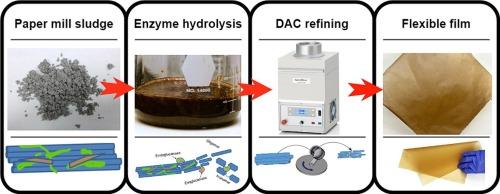Decarbonizing paper mill sludge waste into micro and nanofibrillated cellulose via enzyme hydrolysis and dual asymmetric centrifugation
IF 7.1
2区 环境科学与生态学
Q1 ENGINEERING, ENVIRONMENTAL
引用次数: 0
Abstract
The production of micro- and nano-fibrillated cellulose (MNFC) from paper mill sludge (PS) using simple enzymatic and mechanical treatments has been evaluated for their performance as value-added materials in packaging and other applications. Sludge from a US paper mill was analyzed for the viability of this conversion process. The enzymatic treatment was conducted at variable concentrations using an enzyme cocktail of exoglucanase and endoglucanase, followed by mechanical dual asymmetric centrifugation (DAC) treatment. The presence of inorganics and lignin facilitated the mechanical defibrillation of the fibers, making the MNFC production more energy-efficient. The prepared MNFC was characterized for fibrillation, charge, crystallinity, and surface morphology. Scanning electron microscopic (SEM) images show the highly fibrillated MNFC and the distribution of inorganic nanoparticles on the fiber surface. The X-ray diffractometric (XRD) analysis shows 44–65 % crystallinity. Furthermore, MNFC-based films derived from PS demonstrated excellent strength and flexibility, making them suitable for packaging and other applications. Overall, this conversion approach can save the paper industry millions of dollars in disposal costs while upcycling waste and reducing greenhouse gas (GHG) emissions associated with waste streams.

通过酶水解和双不对称离心将造纸厂污泥废料脱碳为微纤维和纳米纤维素
通过简单的酶解和机械处理,从造纸厂污泥(PS)中生产出微纤维素和纳米纤维素(MNFC),并对其在包装和其他应用中作为增值材料的性能进行了评估。对美国一家造纸厂的污泥进行了分析,以确定这种转化工艺的可行性。在不同浓度下使用外切葡聚糖酶和内切葡聚糖酶的鸡尾酒酶进行酶处理,然后进行机械双不对称离心(DAC)处理。无机物和木质素的存在促进了纤维的机械脱纤,使 MNFC 的生产更具能效。对制备的 MNFC 进行了纤度、电荷、结晶度和表面形态表征。扫描电子显微镜(SEM)图像显示了高度纤维化的 MNFC 以及纤维表面无机纳米颗粒的分布。X 射线衍射(XRD)分析显示结晶度为 44-65%。此外,由 PS 制成的基于 MNFC 的薄膜具有出色的强度和柔韧性,因此适用于包装和其他应用。总之,这种转化方法可以为造纸业节省数百万美元的处理成本,同时还能实现废物的再循环利用,减少与废物流相关的温室气体(GHG)排放。
本文章由计算机程序翻译,如有差异,请以英文原文为准。
求助全文
约1分钟内获得全文
求助全文
来源期刊

Waste management
环境科学-工程:环境
CiteScore
15.60
自引率
6.20%
发文量
492
审稿时长
39 days
期刊介绍:
Waste Management is devoted to the presentation and discussion of information on solid wastes,it covers the entire lifecycle of solid. wastes.
Scope:
Addresses solid wastes in both industrialized and economically developing countries
Covers various types of solid wastes, including:
Municipal (e.g., residential, institutional, commercial, light industrial)
Agricultural
Special (e.g., C and D, healthcare, household hazardous wastes, sewage sludge)
 求助内容:
求助内容: 应助结果提醒方式:
应助结果提醒方式:


